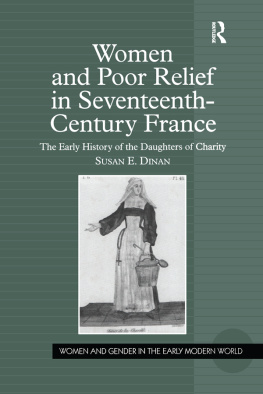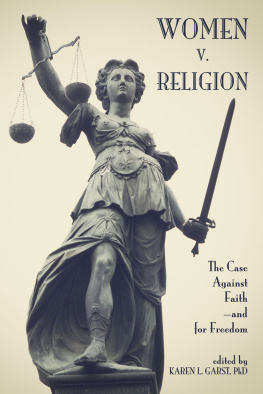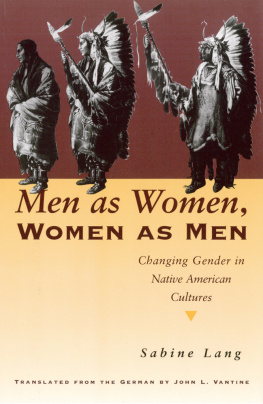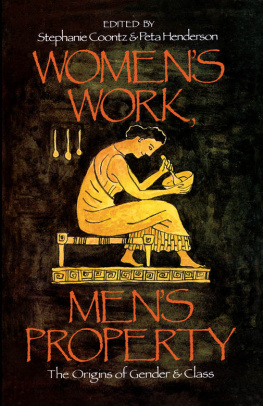First published 1991 by Routledge
Published 2016 by Routledge
2 Park Square, Milton Park, Abingdon, Oxon OX14 4RN
711 Third Avenue, New York, NY, 10017, USA
Routledge is an imprint of the Taylor & Francis Group, an informa business
1991 Karen Anderson
All rights reserved. No part of this book may be reprinted or reproduced or utilized in any form or by any electronic, mechanical, or other means, now known or hereafter invented, including photocopying and recording, or in any information storage or retrieval system, without permission in writing from the publishers.
British Library Cataloguing in Publication Data
Anderson, Karen
Chain her by one foot: the subjugation of women in seventeenth-century
New France.
1. Canada. Society. Role, history of women
I. Title
305.420971
Library of Congress Cataloging in Publication Data
Anderson, Karen L.
Chain her by one foot: the subjugation of Native women in seventeenth-century New France / Karen Anderson.
p.cm.
Includes bibliographical references ()
1. Huron Indians Women History 17th century. 2. Montagnais Indians Women History 17th century. 3. Marriage New France History 17th century. 4. Sex role New France History 17th century. 5. Converts, Catholic New France History 17th century. I. Title.
ISBN 13: 978-0-415-90827-6 (hbk)
I wish to thank a number of people who read and commented on this book in manuscript form. Bonnie J. Fox, Kieran Keohane, Sedef Arat Ko, Katherine Kopinak, Meg Luxton, Julia OConnor and Ester Reiter all gave me valuable suggestions, encouragement and help. My special thanks go to my husband, Gary Woodill, whose generous support, editorial skills and critical acumen helped me to shape this book.
In 1643 the Jesuit missionary Barthelemy Vimont described a marriage which took place at Sillery, just above Quebec City, between Charles and Marie Meiaskawat, two native converts.
The zeal of Charles Meiaskawat is agreeable as it is fervent. Before being baptized, he had taken a wife who was of a very arrogant and violent temper, and who had no inclination toward the Faith. Nevertheless, he made himself worthy of Baptism and received it, while she always stubbornly persisted in her unbelief. He tried to soothe her, and to incline her gradually to the Faith, with admirable patience. He succeeded; she urgently asked for Baptism and obtained it. It was proposed that they be married according to the Church, so as to give their marriage the character and the grace of that Sacrament. They both agreed to this, and proceeded to the Church to receive the Blessing of the Priest, who first asked Charles if he took such a one for his wife. Wait a little, answered Charles; and, turning to his wife, he said: But thou, wilt thou continue to be proud, disobedient and ill-tempered, as in the past? Answer me; for, if thou wilt not behave better, I will not take thee for my wife, I shall easily find another. She was quite abashed, and replied that she would conduct herself better in the future. Speak louder, said Charles; we do not hear thee. When thou art angry, thou screamest like a mad woman; and now thou wilt not open thy mouth. The poor woman had to shout aloud, and protest publicly that she would be obedient to her husband, and live with him in gentleness and in the utmost humility. That is right, said Charles, provided thou doest as thou sayest; otherwise thou wilt cause me to be angry; and, if I get angry, I shall go to Hell, and so wilt thou. Then speaking to the Father, Go on, he said, I am satisfied. I will always love her as my only and my lawful wife.
Vimont went on to comment:
God has visibly blessed this marriage, and we have never seen a greater change than in this woman, who has now become truly a lamb, and has very deep and affectionate feelings of devotion.
(Thwaites 18961901, 25:1757)
The description of that marriage made up a small part of the annual report of 1642 that Lalemant, as head of the Jesuit missions in New France, was required to send to his Superior in Rome. Each report, or Relation, was subsequently published in France for sale to the general public.
Several things interested me about this particular passage. First, and most simply, was the way in which Charles and Marie are recorded as having spoken to each other, what they said and what they did during the ceremony, the way in which they expressed their sentiments, feelings, emotions. Maries response to her husbands direct criticism, as well as Charles pointed identification of Marie as a potential source of danger (if she made him angry he would go to Hell, but so would she) particularly caught my attention.
Second was the very fact that such an account of the marriage between two converts existed at all, and that it was not just a mere accounting, but something which passed for being a recording of words exchanged during the course of a wedding ceremony. If that were not enough, the commentary of the same priest who performed the ceremony was included. Why should the Jesuits, from the moment of their arrival among the Huron and the Montagnais in 1632, have made a practice of recording the details of their progress in converting them to Christianity? Why should the vows exchanged by two obscure people in the backwoods of a remote land be so painstakingly recorded? Why would those documents be sent, not only to Jesuit Superiors in France and Rome, but also to the printers?
The third thing of interest was the difference between what Charles and Marie said during their marriage ceremony, and other conversations between men and women, previously recorded by the Jesuits. At first, and almost invariably, women appeared in the pages of the Relations in a negative light, described as firebrands of Hell, haughty, proud; women did as they pleased, they acted with wanton they acquiesced to no one. They censured and ostracized their Christian spouses. They cursed the Jesuits and called for their deaths.
Charless and Maries wedding day was not the first time the couple had appeared in the pages of the Relations. But in earlier representations this couple had been cast in the role of example of the problems faced by a good Christian man who had a haughty tempered and spiteful wife. Yet their relationship had changed dramatically in the one year between 1641 (the date they first appeared in the pages of the Relations) and their Christian marriage in 1642.
Charles and Marie were first mentioned by the Jesuit Vimont, in the course of his discussion of three Montagnais families recently settled at Sillery, a Christian village the Jesuits were in the process of establishing just above Quebec City with money donated from a wealthy and pious French patron. Marie was singled out for special attention at that time because she was the only one out of the three families who had not yet converted to the Christian faith. Her instruction was proceeding slowly, and Vimont described her as a rough, wild creature who gives a great deal of trouble to the poor man [i.e. to Charles] (ibid. 20:195).
Her behaviour was apparently the cause of a great deal of distress for her husband who feared (in keeping with his Christian instruction) that his wifes anger attracted Demons to his cabin. I fear that the Demons she keeps in my cabin, he is reputed to have said, are perverting the good that I received in holy Baptism (ibid. 20:195). Charles added that I earnestly believe in God and I wish to obey him; and, since I have learned that sin drove God from our hearts, when another does evil in my presence, I fear that may bring loss to my soul (ibid. 20:195). At one point Marie had apparently tried to stab Charles in the thigh with a knife but he had evaded the blow and only his blanket was slashed. It was with obvious pride that Charles displayed this evidence of his wifes misbehaviour to his fellow Christians at Sillery saying: See the anger of her who considers me her servant; she thought she would be able to irritate me, but I have more power over myself than to fall into a passion at the anger of a woman (ibid. 20:197).










